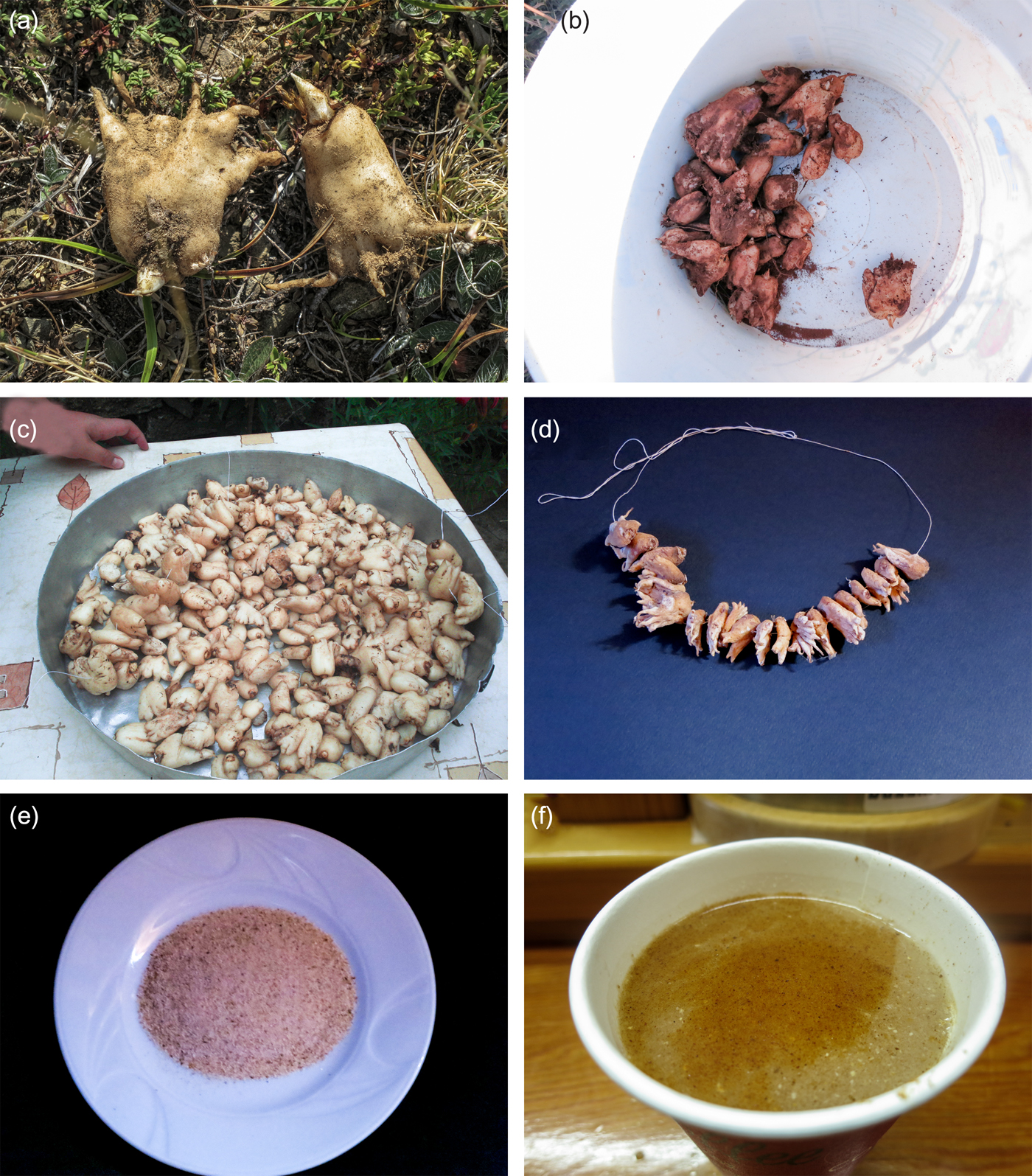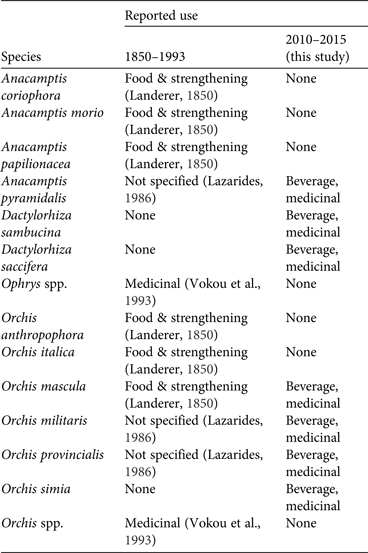Orchids have a history of use in many cultures. They are a significant source of nourishment, and many species are used as aphrodisiacs (Bulpitt, Reference Bulpitt2005). In Tanzania, Zambia and Malawi, for example, tubers of terrestrial orchids are used in making a staple food called chikanda (Davenport & Ndangalasi, Reference Davenport and Ndangalasi2003; Veldman et al., Reference Tamer, Karaman and Copur2014). In the eastern Mediterranean, dried tubers of terrestrial orchids are known as salep, which also refers to ground tuber powder and the beverage made from this powder. Salep is used in ice-cream production, confectionery and beverages (Kasparek & Grimm, 1999; Tamer et al., Reference Sumpter, D'Ayala, Parfitt, Pratt and Raper2006). In Greece it is used mainly in a beverage known as salepi, which is sold in local markets and is popular as a warming drink during the winter (Starin, Reference Sezik2012). Before the introduction of coffee the salep beverage was a common drink in Europe (Landerer, Reference Kasparek and Grimm1850), but now it is consumed mainly in Greece (Starin, Reference Sezik2012) and Turkey (Sezik, Reference Sezik2002; Bulpitt, Reference Bulpitt2005).
Although synthetic alternatives to salep exist, such as cereal starch or carboxymethyl-cellulose (Tamer et al., Reference Sumpter, D'Ayala, Parfitt, Pratt and Raper2006), the demand for orchid tubers remains high among those seeking authentic salep (Kasparek & Grimm, 1999). Sezik (Reference Sezik2006) estimated the annual harvest of genuine salep in Turkey to be as much as 30 t. To produce 1 kg of salep 1,000–4,000 tubers, each representing an individual plant, are required (Kasparek & Grimm, 1999), and this suggests that 30–120 million plants are harvested annually in Turkey alone. In Iran, it is estimated that 5.5–6.1 million orchids are harvested annually, mainly for export to Turkey (Ghorbani et al., Reference Ghorbani, Gravendeel, Naghibi and de Boer2014a).
Orchid use in Greece dates back several millennia. In Historia Plantarum Theophrastus (372–286 BC) attributed medicinal properties to orchid species, and in De Materia Medica Dioscorides (50–70 AD) ascribed healing properties to two terrestrial orchids based on the resemblance of their tubers to testicles (Berliocchi, Reference Berliocchi1996; Bulpitt, Reference Bulpitt2005). In the 1800s salep harvesting by Albanians and Aromanians (Vlachs) was widespread in Greece, and salepi was a winter staple among the working classes (Landerer, Reference Kasparek and Grimm1850). Modern uses of orchids, and salepi in particular, are still based on these ancient traditions.
In Greece the Orchidaceae family is represented by c. 193–212 taxa, depending on species concepts (Delforge, Reference Davenport and Ndangalasi2006; Petrou et al., Reference McGough, Kikodze, Wilford, Garrett, Deisadze, Jaworska and Smith2011), and all orchids are protected under presidential decree 67/1981, national law 1335/1983, and national law 2005/1992, which enacts CITES.
We conducted structured interviews with harvesters, traders and users of orchid tubers in 10 villages in Grevena, Ioannina, Kozani and Thessaloniki prefectures, in the Epirus, West and Central Macedonia regions of Greece (Fig. 1). Local informants, eight women and 17 men aged 40–80 years, were interviewed in the spring and summer of 2013 and 2014. In addition, field visits were made to the collection areas to record species diversity, abundance and harvesting procedures. Relevant literature and herbarium specimens of local orchids were consulted, and all information pertaining to traditional use of salep was recorded (Lazarides, Reference Landerer1986; Vokou et al., Reference Veldman, Otieno, van Andel, Gravendeel and de Boer1993; Kasparek & Grimm, 1999; Tamer et al., Reference Sumpter, D'Ayala, Parfitt, Pratt and Raper2006; Petrou et al., Reference Petrou, Petrou and Giannakoulias2011).

Fig. 1 Ioannina, Grevena, Kozani and Thessaloniki prefectures in Greece, where interviews were conducted with harvesters, traders and users of orchid tubers.
We found that several species in the genera Anacamptis, Dactylorhiza and Orchis are collected for the production of salep (Table 1). Various stages in salep harvesting, processing and consumption are shown in Plate 1. At the time of harvesting, each plant has one old tuber, which has already yielded a flowering plant, and one new perennating tuber, which will yield the next year's plant. The old tuber is scabrous and wrinkled, whereas the new one is fleshy and plump. In most cases collectors harvest the tubers when the plant has finished flowering but before it sets seed, which limits regeneration in wild populations. All informants reported collecting the young fresh tuber only; mostly, the old shrunken tuber is discarded. Three of the informants also reported that a trade in orchids takes place across the border with Albania. All collectors claimed not to be aware that collecting is forbidden, but most expressed interest in maintaining plant populations because they realized that overharvesting can be detrimental.

Plate 1 Freshly collected tubers of Dactylorhiza sambucina from Zagorohoria (a) and Grevena (b); tubers of Dactylorhiza sambucina left to dry in Distrato (c); dried tubers for home use in a village in Grevena (d); ground salep in Distrato (e); and salep beverage for sale near a ski centre (f).
Table 1 Orchid species collected in northern Greece for salep, with past and present reported uses.

In the past, orchid tubers were collected in northern Greece to make salep beverages and a gelatin for porridge, and these were a staple consumed by the working classes (Landerer, Reference Kasparek and Grimm1850). Nowadays, the most popular form of salep is the hot beverage, and the main medicinal uses are to soothe the throat, as a remedy for colds and coughing, and to ease stomach ache and intestinal cramps. In Thessaloniki patisseries prepare dondurma ice cream using powdered salep, and several pharmacies sell a commercial brand of salep-based lozenges and syrup.
A key informant collected salep and sold it as a hot beverage during the winter months from a mobile stall in one of the ski areas in northern Greece. He estimated to use up to 750 g of ground salep per day to prepare 150 cups of hot salep beverage. The street vendors that we interviewed in Thessaloniki obtained dried, unground orchid tubers from middlemen in the trade of tubers from neighbouring Albania and Turkey. One of the vendors estimated using c. 25 kg of raw tubers per year in the production of hot salep beverage. The owner of a company specializing in the trade of local herbs and spices in Kozani had started trading salep only 7 years previously; he reported buying tubers from collectors in northern Greece, most of whom did not reveal their exact harvesting areas or locations. He estimated he had sold 200 kg of ground salep in 2012 and had paid collectors EUR 55–85 per kg for salep of Greek origin. He also noted an increase in demand year by year as the popularity of salep drinks increases. The owner of a herb and spice shop in downtown Thessaloniki informed us that the unpackaged salep he sells is collected in the Grammos mountains. He also reported selling only salep harvested in Greece. Another company operating in the Greek domestic market sold ground salep mixed with corn starch and common spices, such as cinnamon, nutmeg and cloves. The packaging labels claimed that the salep was sourced from cultivated stock but we found no evidence for this. Based on information from informants we established that packaged salep may retail for up to EUR 143 per kg (based on a price of EUR 5−10 for 60−70 g).
The renewed popularity of salep is driven by consumer demand for traditional, organic and alternative food but consumers may not realize that traditional products can contain threatened wildlife. Landerer (Reference Kasparek and Grimm1850) reported various salep species in the genera Anacamptis and Orchis, and reported that these occurred abundantly in Thessaly and Macedonia (Table 1). Vokou et al. (Reference Veldman, Otieno, van Andel, Gravendeel and de Boer1993) reported the use of species of Ophrys and Orchis but mentioned no specific species of either genus. We discovered that seven species of three genera, Anacamptis, Dactylorhiza and Orchis, are used for the production of salep in northern Greece. The use of Dactylorhiza has not been reported previously in Greece, but it has been reported in Turkey (Kasparek & Grimm, 1999) and Iran (Ghorbani et al., Reference Ghorbani, Gravendeel, Zarre and de Boer2014b), probably following overharvesting of the more desired genera Anacamptis and Orchis. Several species used in the past for salep production have become more rare in recent decades as a result of overharvesting. Several species of Ophrys have been added to the IUCN Red List (IUCN, Reference Hawkes2013), possibly spurred by the use of additional species for salep production.
The collectors that we followed in the field left only a few smaller plants standing during collecting. In most cases there were holes in the ground, indicating that other collectors had already been to the area. In the 1850s Landerer reported that the main harvesting season was the autumn, when the meadows and terraces were tilled, and the orchids had set seed and wilted. He also wrote that the tubers were selected by size, and many of the smaller tubers were replanted to promote regrowth. Sumpter et al. (Reference Starin2004) provided experimental evidence of the regenerative capacity of old orchid tubers. We recorded neither dispersal of young tubers nor replanting of old tubers.
The annual harvests of thousands of 50 kg (centner) units of salep reported in the 1850s (Landerer, Reference Kasparek and Grimm1850) no longer occur, as orchids have become rare and remaining populations have lost resilience to such harvesting pressure (Petrou et al., Reference McGough, Kikodze, Wilford, Garrett, Deisadze, Jaworska and Smith2011). The number of fresh orchid tubers harvested per kg of salep is estimated to be 220–250 (Ghorbani et al., Reference Ghorbani, Gravendeel, Naghibi and de Boer2014a). In Iran, where an orchid collection boom is threatening wild populations, an estimated 6 million tubers are harvested annually (Ghorbani et al., Reference Entwistle, Atay, Byfield and Oldfield2014a).
The increasing popularity of traditional, organic food provides much-needed opportunities for an alternative source of income for the people of north-western Greece. Salep can be produced sustainably, and the species of orchids that yield the best salep (Orchis mascula, Orchis militaris and Anacamptis morio; Hawkes, Reference Ghorbani, Gravendeel, Zarre and de Boer1944) can be cultivated (Seaton & Ramsay, Reference Seaton and Ramsay2005). Local propagation and sustainable cultivation alleviate harvesting pressure on wild orchids but subsequent trade poses challenges in the context of national and international legislation, such as CITES (Entwistle et al., Reference Delforge2002; McGough et al., Reference Lazarides2014). Our survey revealed ongoing and increasing collection of wild orchids, and we are now informing local authorities of the implications of commercialization of salep products. We are also working with collectors who expressed an interest in piloting small-scale cultivation, and companies interested in sustainably cultivated salep, to provide expertise on seed collecting, propagation and cultivation. Subsequent questions about commercialization within the framework of national legislation have not yet been addressed.
Acknowledgements
We thank all informants for sharing their knowledge. In addition we acknowledge the staff of the Lazarides Folklore Museum in Koukouli for their assistance, Erik-Jan Bosch for creating Fig. 1, and Socrates Tsouplakis for creating Fig. 2.
Biographical sketches
Anna Kreziou is a biologist and teacher in Thessaloniki, and is conducting research on trade and identification of orchids. Hugo de Boer combines ethnobotany and DNA barcoding to elucidate species identity and diversity of wild-harvested plants in international trade. Barbara Gravendeel is an orchidologist and molecular biologist specialized in DNA barcoding and wildlife forensics.







